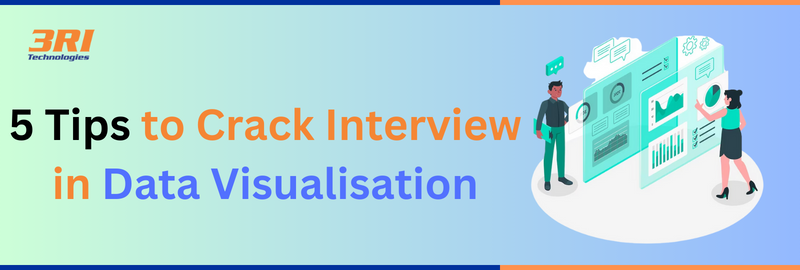Professionals with experience in Data Visualization are in high demand due to the rapid advancements in the field of Data Analytics. A Data Visualization specialist’s role is becoming increasingly important as companies attempt to leverage their data to make informed decisions. Work in this highly competitive industry requires technological proficiency and a thorough understanding of the art and science of transforming complex data into insightful graphics. Today, we’ll talk about 5 tips to crack the interview to help you land your next Data Visualization job.
Why Data Visualization Skills Matter in Today’s Job Market
As data becomes central to business decision-making, professionals who can translate numbers into compelling visuals have a clear advantage. Employers are actively looking for candidates with hands-on experience in data visualization techniques and familiarity with widely used data visualization tools such as Tableau or Power BI.
Whether you’ve taken a certified data visualization course or worked on self-initiated projects, showcasing your ability to communicate insights visually is now a key interview differentiator. Recruiters especially value candidates who demonstrate practical application, not just theory.
For learners in tech-driven cities like Pune, the rise of job-linked Data analytics courses in Pune and online data visualization programs has made skill-building more accessible. These programs often align with placement opportunities and are tailored to current industry needs.
If you’re preparing for a data-related role—whether in analytics, business intelligence, or data science—sharpening your visual storytelling skills is a smart step toward interview success.

Upskill with a Structured Data Visualization Course
1. Portfolio Showcase
Your portfolio is the blank page that shows how much you’ve learned about how to present facts. There’s more to the report than just graphs and charts. It shows how you’ve grown, how creative you are, and how well you can turn data into useful information. You should have a lot of different projects in your portfolio to show that you can work with varying types of data and companies. Ensure that each piece in your portfolio has an interesting story, such as the problem you solved, the data issues you ran into, or the impact of your visualizations.
Your professional skills, as well as your imagination and ability to come up with new ideas, should all be shown off in a well-organized portfolio. Employers want more than just standard answers; they want to see how you can show data in a way that no one else can. Read your resume and consider how it shows your skills have changed. Focus on the lessons you’ve learned and how you’ve grown as a Data Visualization worker.
Learn the Power BI skills from Industry Expert Trainers only at Power BI Course in Pune
2. Mastery of Visualization Tools
Working with Data Visualization requires proficiency with the necessary tools. Whether it’s because of these programs’ intuitive user interfaces (like Tableau and Power BI) or the versatility offered by Python modules (like Matplotlib and Seaborn), mastery of these tools is crucial. To demonstrate your expertise with these technologies during the interview, evaluate specific projects in which you have produced impactful visualizations using them.
Explain how you chose the right tool for a specific task. Discuss the advantages and disadvantages of each tool and how your choice will impact the visualization’s overall power. Show off your adaptability by showcasing your skill with various tools and emphasizing your commitment to staying current with the latest advancements in data visualization technologies. This demonstrates your technical proficiency and reassures the interviewer about your ability to work well with their present workflow.
3. Storytelling with Data
Telling a relatable story is just as important as displaying numbers when using Data Visualization. Discuss how you structure your visuals to communicate an engaging and logical tale throughout the interview. This will enable you to demonstrate your storytelling prowess. Provide instances of your work on projects where you used data storytelling to influence decisions and make things easier for people to grasp.
Knowing your audience and tailoring your story to their level of understanding is essential for crafting an effective data story. Engagingly communicating complex concepts is crucial, regardless of the audience you are speaking to – C-suite executives or colleagues in other departments. Discuss the process of developing a storyline, the usage of annotations, and the systematic placement of essential concepts in your visualizations. This will demonstrate your ability to communicate effectively and commitment to ensuring that your illustrations result in meaningful action.
4. Attention to Aesthetics and Clarity
Aesthetics and clarity go hand in hand in the field of Data Visualization. Your images should be informative and visually engaging. Throughout the interview, examine your approach to color theory, font choices, and overall design concepts. During the interview, you should discuss color theory, font choice, and design in general. Discuss how you achieve a balance between originality and simplicity to ensure that your visualizations are not just appealing but also understandable.
Professionals who can make images that are both correct and appealing to the eye are in high demand. Paying attention to how your visualizations look should make them more powerful overall, making them easier to remember and more attractive to your audience. Showcases from your portfolio where your design choices were essential in getting your message across, and discuss any problems you ran into when balancing good looks with the need for clear communication. Excel in the art of Data Analytics by enrolling in our Data Analytics Course in Pune.
5. Problem-Solving Demonstrations
Finally, data representation is a way to solve problems in the real world. An essential part of your interview is showing how your images solved complex problems. You should be ready to show the interviewer specific examples of how your visualizations helped you make better decisions or gain useful insights.
Talk about how you solved problems from the start of a project, including finding the biggest problems, cleaning and changing the data, and choosing the best ways to display it. Show how your ideas worked by showing real-world outcomes or results that came from your visualizations. Employers are interested in more than how technically skilled you are; they want to know how you can use your skills to make a real difference in their business.
The Closing Note
Succeeding in a Data Visualization interview demands a comprehensive strategy beyond technical expertise. These are the best tips to crack interview for the same. Therefore, you position yourself as a well-rounded data visualization professional by showcasing a carefully chosen portfolio that tells your story, proving your proficiency with visualization tools, stressing your data storytelling abilities, paying attention to clarity and aesthetics, and showcasing your problem-solving skills. Remember that it’s not enough to make graphics; you also need to write a story that turns data into ideas that can be used. Now that you know these tips, you can impress possible employers and do great in the ever-changing field of Data Visualization. To Learn From the Experts Visit 3RI Technologies.



